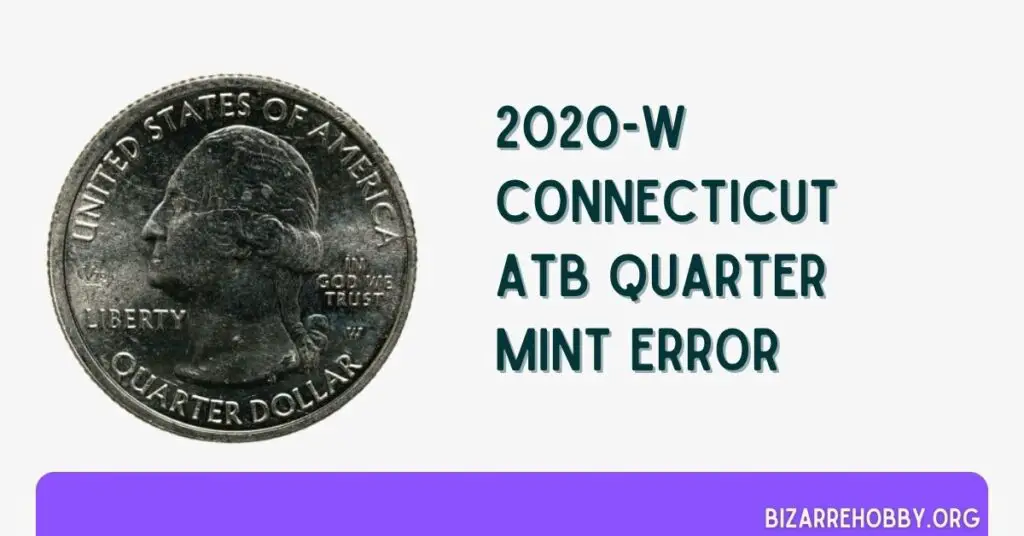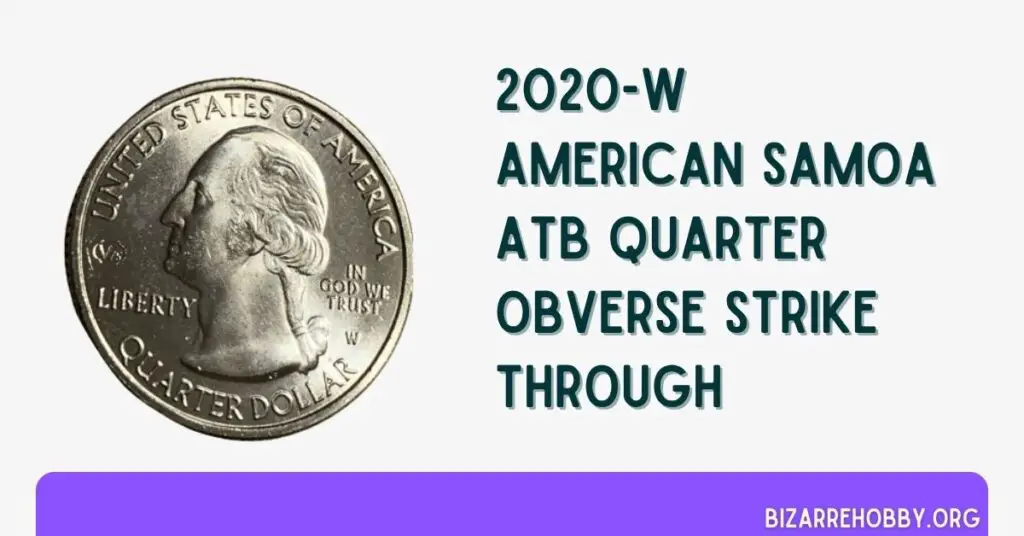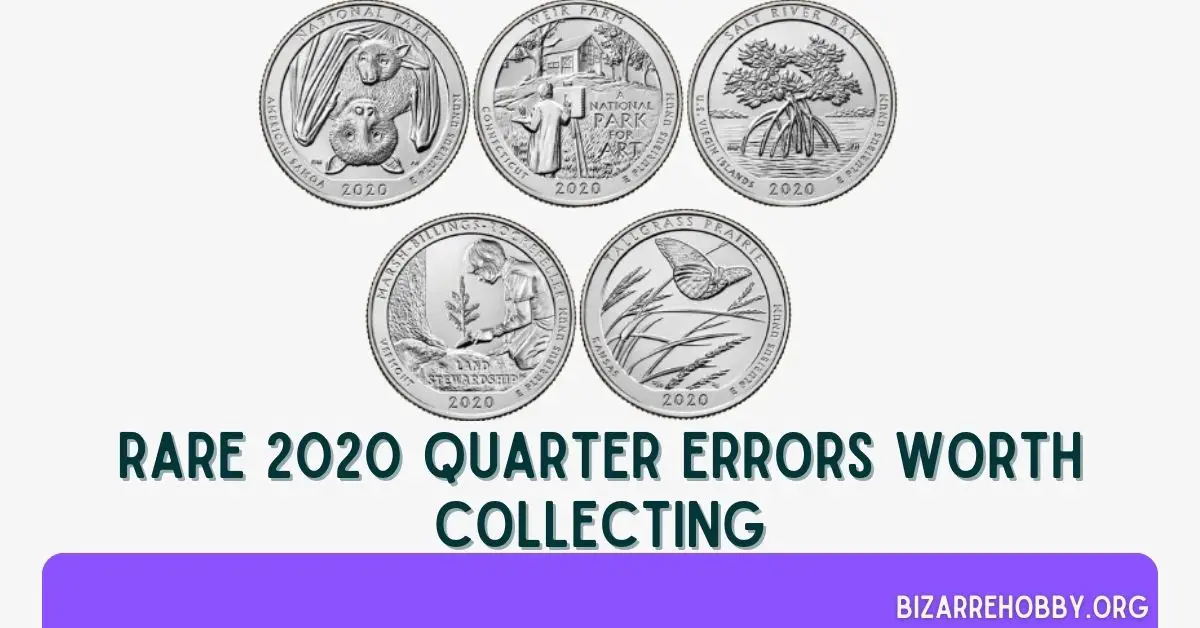In 2020, the United States Mint continued its America the Beautiful (ATB) series, striking five quarters featuring national parks and monuments from various states and territories. This year’s releases honored American Samoa, the U.S. Virgin Islands, Vermont, Connecticut, and Kansas. As with any minting process, errors occurred during production, creating rare and valuable variants sought after by collectors. Let’s delve into some of the most intriguing 2020 quarter errors.
1. The Elusive “Faceless Bat” Error of American Samoa

The 2020 American Samoa quarter showcases a Samoan fruit bat, also known as a flying fox, nurturing its pup. This megabat species, larger than typical insectivorous bats, is a crucial pollinator in the ecosystems of American Samoa National Park. Some coins from this series feature a striking error where the mother bat’s face appears blurred or partially obscured.
This flaw likely resulted from a strike-through error or a die break (cud). The severity of the obscuration varies, affecting either the entire face or just the left eye area. Depending on the extent of the error, these coins can fetch between $50 and $500 in the collector’s market.
2. 2020-D American Samoa ATB Quarter 98% Reverse Clad Missing

Modern U.S. quarters utilize a clad composition, consisting of a pure copper core sandwiched between outer layers of 75% copper and 25% nickel. This design, known as the “Johnson Sandwich,” was implemented in 1965 to address a silver shortage that had led to widespread hoarding of silver coins.
In a rare minting error, a 2020-D American Samoa quarter emerged with approximately 98% of its reverse (tails side) clad layer missing, exposing the copper core. This dramatic error resulted in a coin with a standard silvery obverse but an almost entirely copper reverse. An MS 66 (Mint State 66) graded specimen of this error sold for $2,499, highlighting its rarity and appeal to collectors.
3. 2020-D Virgin Islands ATB Quarter Struck Thru Error
The 2020 U.S. Virgin Islands quarter, featuring Salt River Bay, presents an intriguing “struck-through” error. This occurs when a foreign object interferes with the minting process, becoming trapped between the die and the planchet (blank coin).
In this case, what appears to be a staple was struck onto the coin and remained attached, creating a retained strike-through error. The impact not only left a visible mark but also stripped away part of the clad layer, revealing the underlying copper. This dramatic error, which appears as a scratch across George Washington’s jawline, sold for $180.
4. 2020-W Connecticut ATB Quarter Mint Error

To commemorate the 75th anniversary of World War II’s conclusion, the U.S. Mint produced 2 million quarters at the West Point facility with a special V75 privy mark. These coins, featuring Connecticut’s Weir Farm National Historic Site, were intended for circulation but became collector’s items due to their limited mintage and special features.
One particular error coin from this series exhibits a flaw obscuring part of George Washington’s eye and forehead. Combined with its first-day-of-issue status and high grade (MS 66), this error coin commanded a price of $390.
5. 2020-P Vermont ATB Quarter Off-Centre Error
Vermont’s entry in the 2020 ATB series depicts a scene from Marsh-Billings-Rockefeller National Historical Park, showing a young girl planting a Norway Spruce seedling. Some of these coins exhibit an off-center strike error, where the planchet was misaligned during the minting process.
This misalignment resulted in part of the design being struck off-center, leaving a portion of the planchet blank. While not a severe case, the error is noticeable, with part of the word “Rockefeller” positioned on the coin’s rim. Despite being a relatively minor error, this coin still sold for $126, demonstrating the premium collectors place on such variations.
6. 2020-P Virgin Islands ATB Quarter Reverse Strike Through
Another example of a strike-through error appears on a 2020-P U.S. Virgin Islands quarter. In this instance, the foreign object (possibly a wire) became trapped on the reverse die, creating a distinctive stripe across the lower portion of the coin’s design.
The impact of the strike-through removed the outer clad layer along its path, revealing a bright copper streak amidst the coin’s silvery surface. This visually striking error, despite originating from the common Philadelphia mint, commanded a impressive price of $560.
7. 2020-W American Samoa ATB Quarter Obverse Strike Through Error

While the “Faceless Bat” error is well-known among 2020 American Samoa quarters, some coins exhibit a different type of strike-through error on the obverse. These appear as gouges or indentations on Washington’s mouth or neck area.
Coins with this error, graded MS 65, typically sell for around $1200. However, specimens with additional desirable features, such as the V75 privy mark, West Point mintage, and “First Week of Discovery” designation from grading services, like NGC and PCGS, can command even higher prices.
8. 2020-P Virgin Islands ATB Quarter DDR

Some errors occur consistently across multiple coins due to flaws in the minting equipment. These are known as varieties. One such variety discovered in the 2020-P Virgin Islands quarter is a doubled die reverse (DDR) error.
Authenticated by error coin expert John Wexler, this variety shows doubling on the right leg of the “M” in the designer’s initials “JFM” (for Joseph F. Menna, Chief Engraver of the U.S. Mint). The initials “RaM” for designer Richard Masters also exhibit doubling. While subtle, these consistent errors are prized by specialized collectors.
9. 2020-W Connecticut ATB Quarter Reverse Ring Error
Sometimes, 2020 quarter errors are difficult to categorize precisely without expert examination. One such example is a 2020-W Connecticut quarter featuring an unusual curved mark or indentation on its reverse side.
This flaw, which resembles a partial doubling of the coin’s outer ring, extends from the state name to the tree line. Its position below the date suggests it may be a planchet-level error rather than a die issue. While its exact cause remains uncertain, the uniqueness of this error makes it valuable to collectors.
10. 2020-D Virgin Islands ATB Quarter Obverse Ring Error
A similar ring-like error appears on some 2020-D U.S. Virgin Islands quarters, but this time on the obverse side. This unexpected feature is particularly noticeable because the obverse of ATB quarters typically lacks an outer ring.
The cause of this error is not definitively known. It could result from a reverse die cap, a form of brockage, or possibly from stacked coins under heat or pressure transferring design elements. Regardless of its origin, this unusual error adds significant interest and value to the coin.
11. 2020-P Vermont ATB Quarter Die Chip
The 2020 Vermont quarter, with its detailed depiction of land stewardship at Marsh-Billings-Rockefeller National Historical Park, requires close examination to spot subtle errors. One such error is a small die chip visible on the young girl’s torso.
Die chips occur when small pieces of the die break off during the minting process, leaving raised areas on the struck coins. While minor, these errors are of interest to specialized collectors and serve as a reminder of the complex processes involved in coin production.
Final Thoughts
All in all, the world of numismatics is filled with fascinating variations and errors that transform ordinary coins into prized collectibles. The 2020 quarter errors discussed here represent just a small sample of the myriad imperfections that can occur during the minting process. For coin enthusiasts, these errors not only add value to their collections but also provide insight into the intricate art and science of coin production.
